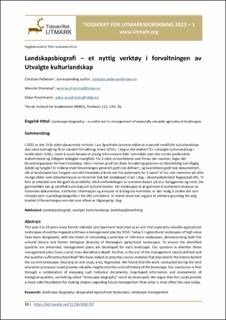Landskapsbiografi – et nyttig verktøy i forvaltningen av Utvalgte kulturlandskap
Journal article

Åpne
Permanent lenke
https://hdl.handle.net/11250/3065787Utgivelsesdato
2023Metadata
Vis full innførselSamlinger
- Tidsskriftet Utmark [67]
Sammendrag
2023 er det 19 år siden daværende minister Lars Sponheim lanserte målet at «spesielt verdifulle kulturlandskap skal være kartlagt og få en særskilt forvaltning innen 2010». I dag er det etablert 51 «utvalgte kulturlandskap i landbruket» (UKL), ment å skulle bevare et utvalg referanseområder som både viser det norske jordbrukets kulturhistorie og tidligere biologisk mangfold. For å sikre at kvalitetene som finnes der ivaretas, lages det forvaltningsplaner for hvert landskap. Men i hvilken grad har disse forvaltningsplanene en tilstrekkelig tverrfaglig dybde og tyngde? Er målene med forvaltningen generelt godt nok definert, og kvalitetene godt nok dokumentert, slik at landskapet kan fungere som det historiske arkivet det har potensiale for å være? Vi har sett nærmere på ulike mulige kilder som dokumentasjon av historien bak det landskapet vi ser i dag, i eksempelområdet Rygnestad UKL. Vi fant at arbeidet som ble gjort da jordskifte, altså omfordelingen av eiendom basert på bl.a. beliggenhet og verdi, ble gjennomført kan gi verdifull kunnskap om kulturhistorien. Vår konklusjon er at gjennom å kombinere analyser av historiske dokumenter, kartfestet informasjon og analyser av biologiske kvaliteter, er det mulig å utvikle det som omtales som «Landskapsbiografier» for UKL områdene. Vi mener disse kan utgjøre et sterkere grunnlag for valg knyttet til forvaltningen enn det som oftest er tilgjengelig i dag. This year it is 19 years since former minister Lars Sponheim launched as an aim that especially valuable agricultural landscapes should be mapped and have a management plan by 2010. Today 51 agricultural landscapes of high value have been designated, with the intent of conserving a selection of reference landscapes, demonstrating both the cultural history and former biological diversity of Norwegian agricultural landscapes. To ensure the identified qualities are preserved, management plans are developed for each landscape. Our question is whether these management plans have a solid cross-disciplinary depth. Further, is the aim of the management clearly defined and the qualities sufficiently described? We have looked at potential source-material that documents the history behind the current landscape, focusing on one study area, Rygnestad. We found that the work conducted during the land allocation processes could provide valuable insights into the cultural history of the landscape. Our conclusion is that through a combination of analysing such historical documents, map-based information and assessments of biological qualities, something called “landscape biography” could be developed. We argue that this could provide a more solid foundation for making choices regarding future management than what is most often the case today.